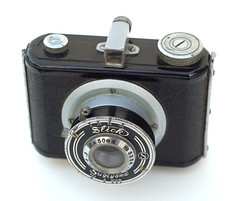Slick
The Slick is a Japanese camera taking 3×4cm exposures on 127 film, made in the first half of the 1940s.
Sources
The Slick appears for ¥19 in the official list of set prices compiled in October 1940 and published in January 1941, with no further detail.[1] It is also mentioned in the government inquiry listing Japanese camera production as of April 1943, where it is registered as made by Sugiyama and distributed by Nomura.[2] (Recent sources attribute the camera to Tōa Kōki, certainly by mistake.)[3] Only three surviving examples have been observed so far, with lens no.3217, no.3334, and no.5370.[4]
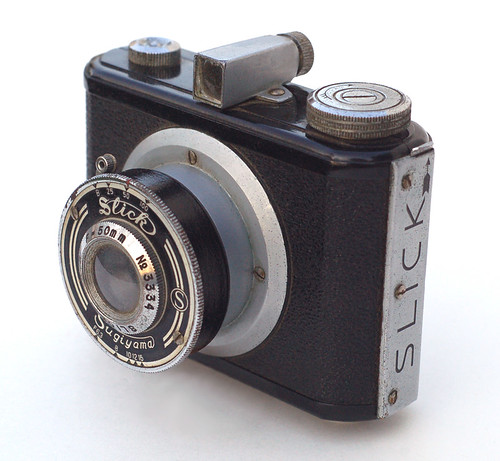
|
| Slick with lens no.3334. Picture by John Kratz. (Image rights) |
Description of the body
The Slick has a bakelite[5] body and a telescopic tube supporting the lens and shutter assembly. The advance knob is at the left end of the top plate, as seen by the photographer, and has three rows of knurls. There is a tubular finder in the middle of the top plate and a small film flange at the right end. The back is hinged to the right and contains two red windows. It is locked by a sliding bar on the left, and the latch is covered by a plate with the name SLICK in large capital letters.
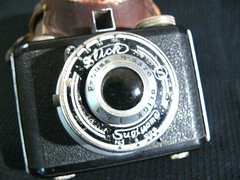 
|
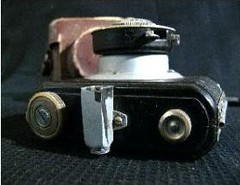 
|
| Slick with lens no.5370. Pictures copyright by michiko_722. (Image rights) |
Lens and shutter equipment
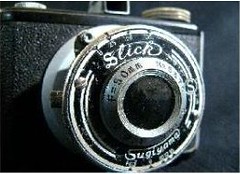
|
| Lens and shutter. Picture copyright by michiko_722. (Image rights) |
The lens and shutter unit was made by the Sugiyama company.[6] The lens is a two-element[7] Slick 50mm f/6.3, engraved SLICK 1:6.3 F=50mm N°xxxx. On all the examples observed, the shutter is everset and gives B, 25, 50, 100 speeds, selected by turning the rim, but the 1943 inquiry mentions B, 25–150 speeds.[8] The aperture is selected by an index at the bottom, with 6.3, 8, 10, 12, 15 settings. The shutter plate is marked Slick at the top and Sugiyama at the bottom, and has a logo on the right, showing the letter "S" inside a circle.
Notes
- ↑ "Kokusan shashinki no kōtei kakaku", type 1, section 1.
- ↑ "Kokusan shashinki no genjōchōsa" ("Inquiry into Japanese cameras"), item 156.
- ↑ Sugiyama, item 4069; Zaisu Ikon, p.9 (says "Tōa Kōki Kenkyūjo": 東亜光機研究所).
- ↑ Lens no.3217: example pictured in Zaisu Ikon, p.9, and in Sugiyama, item 4069. Lens no.3334 and 5370: examples pictured in this page.
- ↑ The "Kokusan shashinki no genjōchōsa" ("Inquiry into Japanese cameras"), item 156, says that the camera is made of "alloy", perhaps by mistake.
- ↑ "Kokusan shashinki no genjōchōsa" ("Inquiry into Japanese cameras"), lens item Jd1, shutter item 18-V-11.
- ↑ "Kokusan shashinki no genjōchōsa" ("Inquiry into Japanese cameras"), lens item Jd1.
- ↑ B, 25, 50, 100: example pictured in Sugiyama, item 4069, and in Zaisu Ikon, p.9. B, 25–150: "Kokusan shashinki no genjōchōsa" ("Inquiry into Japanese cameras"), shutter item 18-V-11.
Bibliography
- "Kokusan shashinki no genjōchōsa" (国産写真機ノ現状調査, Inquiry into Japanese cameras), listing Japanese camera production as of April 1943. Reproduced in Supuringu kamera de ikou: Zen 69 kishu no shōkai to tsukaikata (スプリングカメラでいこう: 全69機種の紹介と使い方, Let's try spring cameras: Presentation and use of 69 machines). Tokyo: Shashinkogyo Syuppan-sha, 2004. ISBN 4-87956-072-3. Pp.180–7. Item 156.
- "Kokusan shashinki no kōtei kakaku" (国産写真機の公定価格, Set prices of the Japanese cameras), listing Japanese camera production as of October 25, 1940 and setting the retail prices from December 10, 1940. Published in Asahi Camera January 1941 and reproduced in Shōwa 10—40nen kōkoku ni miru kokusan kamera no rekishi (昭和10〜40年広告にみる国産カメラの歴史, Japanese camera history as seen in advertisements, 1935—1965). Tokyo: Asahi Shinbunsha, 1994. ISBN 4-02-330312-7. Pp.108—9. Type 1, section 1.
- Sugiyama, Kōichi (杉山浩一); Naoi, Hiroaki (直井浩明); Bullock, John R. The Collector's Guide to Japanese Cameras. 国産カメラ図鑑 (Kokusan kamera zukan). Tokyo: Asahi Sonorama, 1985. ISBN 4-257-03187-5. Item 4069.
- Zaisu Ikon (座椅子遺恨, probably a pseudonym of Y. Saji). "Besuto sanka (hoi 3)" (ベスト讃歌[補遺3], Vest hymn [appendix 3]). In Camera Collectors' News no.99 (September 1985). Nishinomiya: Camera Collectors News-sha. P.9.
This camera is not listed in Kokusan kamera no rekishi.
